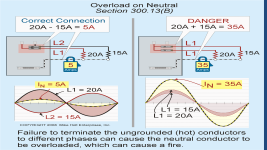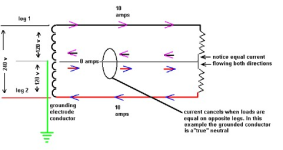What is the unbalanced current?
A neutral conductor that carries only the unbalanced current from other conductors of the same circuit shall not be required to be counted when applying the provisions of
310.15(C)(1).
Essentially, the idea of this rule, is that if it is possible for there to be zero current on the neutral, when all ungrounded conductors run at maximum capacity, then you do not need to count the neutral. Consider all possibilities of how current is distributed among all conductors that could carry it. The sum of heat generated by all conductors including the neutral, will never exceed what it would be, if the ungrounded conductors run at full load. This assumed no harmonic distortion, which is another issue to consider later.
As a split-phase example, consider a 100A feeder, with 100A on the black line, and 60A on the red line. 60% of the amps on the black line are carried back on the red line that is 180 degrees out of phase with it. The remaining 40A return on the neutral. Consider each milliohm of wire resistance and length for each phase and each neutral. This means that the heating is (100^2 + 60^2 + 40^2)*0.001 = 15.2 Watts of ohmic losses. Had both red and black lines carried 100A, with nothing on the neutral, we'd get (100^2 + 100^2)*0.001 = 20 Watts. No matter what the imbalance is, we'd never get more than 20 W of heat generated.
Similar example, but 3-phase, with 100A on phase A, 75A on phase B, and 60A on phase C. Corresponding neutral current = sqrt(SOS - SOP) = sqrt(100^2 + 75^2 + 60^2 - (100*75 + 75*60 + 100*60)) = 35A. Total heating per milliohm of 1-way length, is 20.45 Watts. For a balanced system with 100A on all 3 phases and no neutral current, the heating is 30 W. No matter what imbalance you try, you'll get less than 30 Watts in this situation.
Where neutral is required to count as a CCC:
1. If neutral is a mandatory part of the return path, such that it isn't possible to have zero current on it at full load, even with balancing. Examples being individual phase-to-neutral loads, and two phases + neutral derived from a 3-phase wye system. The neutral is mandatory to allow the current to add up (as vectors) to zero, as is required per Kirchhoff's laws.
2. Harmonic intensive loads, particularly triplen harmonics (multiples of 180 Hz in the US), where currents accumulate instead of cancel on the neutral. Less of an issue, but still a requirement to consider for non-linear loads, where current is a different wave shape than the voltage.




